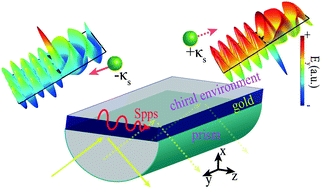Optical lateral forces and torques induced by chiral surface-plasmon-polaritons and their potential applications in recognition and separation of chiral enantiomers†
Abstract
Surface plasmon polaritons carry an intrinsic transverse spin angular momentum which is locked to their propagation direction due to the quantum spin Hall effect of light. We study the chirality-sorting lateral optical forces arising from this phenomenon in a Kretschmann configuration. We show that the characteristics of surface plasmon polaritons are affected by small changes of the environment's chirality. This property can be utilized to detect the medium's chirality in the macro-world. Furthermore, we explain how the the lateral forces and optical torques interact with the chirality of nano-particles located or adsorbed in the vicinity of the surface in the micro-world. Finally, we demonstrate that introducing one handedness of chirality to the dielectric medium in the Kretschmann configuration will benefit the discrimination of chiral enantiomers compared with the nonchiral case. Our work presents physical insights into chirality-selective lateral forces using surface plasmon polaritons and provides a new approach to discriminating and separating chiral enantiomers in the chemical and pharmaceutical industries.



 Please wait while we load your content...
Please wait while we load your content...